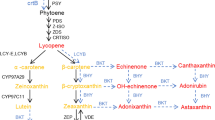Summary
The wild species of tomato,Lycopersicon minutum, carries a factor which after introduction into cultivated varieties ofL. esculentum results in an increasing concentration of β-carotene in fruits. The factor is closely linked to the sp+ gene in chromosome 6 (0.12 % c.o.). This allows to conclude that it is either the B gene or a very similar allele. (The fruit flesh ofL. minutum is greenish white and contains very small quantities of carotenoids; this is perhaps due to the absence of the r+ gene). The results of the present study and findings of other workers suggest that the gene B occurs in all species of the genusLycopersicon and only a part ofL. esculentum and a part ofL. pimpinellifolium are the exceptions in having the allele B+.
Some segregants characterised by remarkably increased amount of both β-carotene and lycopene have been isolated from the cross between high β-carotene line and the hp mutant.
Zusammenfassung
Die WildtomateLycopersicum minutum enthält einen Faktor, der, auf KulturtomatenL. esculentum übertragen, eine beträchtliche Zunahme des Gehaltes an β-Carotin in den Früchten verursacht. Dieser Faktor ist eng verbunden mit dem sp+-Gen im 6. Chromosom (0,12 % c.o.). Dies läßt vermuten, daß es entweder das B-Gen oder ein sehr ähnliches Allel ist. (Die Früchte vonL. minutum haben grünlich-weißes Fleisch und enthalten sehr kleine Mengen von Karotinoiden; das hängt höchstwahrscheinlich mit der Abwesenheit des r+-Gens zusammen). Auf Grund von eigenen Arbeiten und Arbeiten anderer Autoren kann man vermuten, daß das B-Gen in allen Arten der GattungLycopersicum anwesend ist und nur einige Varietäten vonL. esculentum undL. pimpinellifolium ausnahmsweise das B+-Allel besitzen.
Als Ergebnis einer Kreuzung zwischen der Linie mit erhöhtem Gehalt an β-Carotin und den Mutanten hp hat man Segreganten erhalten, welche sich durch einen erhöhten Gehalt sowohl an β-Carotin wie an Lykopin auszeichnen.
Résumé
Une espèce de tomate sauvage,Lycopersicon minutum, contient un facteur qui — après avoir été introduit dans les variétés cultivées — détermine un taux élevé de β-carotene dans les fruits. Ce facteur est étroitement associé avec le gène sp+ du chromosome 6 (0.12 % c.o.), ce qui permet de supposer qu'il s'agit ou bien du gène B ou d'un allèle très ressemblant. (La pulpe du fruitL. minutum est d'un blanc verdâtre et contient de très petites quantités de caroténoides, peutêtre à cause de l'absence du gène r+). Il résulte de cette étude ainsi que des données puisées dans d'autres, qu'on peut supposer que le gène B se trouve dans toutes les espèces du genreLycopersicon et seulement une partie de l'espèceL. esculentum et une partie de l'espèceL. pimpinellifolium sont des exceptions qui possèdent l'allèle B+.
Par croisement entre la lignée enrichie de β-carotene et le mutant hp, on a obtenu des ségrégants caractérisés par une plus forte concentration aussi bien de β-caroténe que de lycopène.
Similar content being viewed by others
Literature
Ames, St. R., H. A. Risley &P. A. Harris., 1954. Simplified procedure for extraction and determination of vitamin A in liver.Anal. Chem. 26:1378-.
Berger, St., 1953. Metoda ilościowego oznaczania β-karotenu (prowitaminy A) i sumy karotenoidów w niektórych produktach roślinnych.Roczniki P. Z.H. 4:473–479.
Chmielewski, T., 1962. Cytogenetical and taxonomical studies on a new tomato form. Part I.Genet. Polonica 3:253–264.
Chmielewski, T., 1963. A factor fromL. minutum affecting the beta-carotene content.Rept. Tomato Genet. Coop. 13:10–11.
Chmielewski, T., 1965.L. minutum contains the gene B.Rept. Tomato Genet. Coop 15:28–29.
Chmielewski, T. &St. Berger,,1962. Inheritance of beta-carotene content in tomatoes.Genet. Polonica 3:155–159.
Chmielewski, T. &C. M. Rick., 1962.Lycopersicon minutum.Rept. Tomato Genet. Coop. 12:21–22.
Ito, P. &T. M. Currence., 1964. A linkage test involving c sp B+ md in chromosome 6.Rept. Tomato Genet. Coop. 14:14–15. Cited by permission.
Kohler, G. W., R. E. Lincoln, J. W. Porter, F. P. Zscheile, R. M. Caldwell, R. H. Harper &W. Silver., 1947. Selection and breeding for high beta-carotene content (Provitamin A) in tomato.Bot. Gaz. 119:219–225.
Lesley, J. W. &M. M. Lesley., 1947. Flesh color in hybrids of tomato.J. Hered. 38:245–251.
Lesley, M. M. &J. W. Lesley., 1943. Hybrids of the Chilean tomato.J. Hered. 34:199–200.
Lincoln, R. E. &J. W. Porter., 1950. Inheritance of Beta-carotene in tomatoes.Genetics 35:206–211.
Lincoln, R. E., F. P. Zscheile, J. W. Porter, G. W. Kohler &R. M. Caldwell., 1943. Provitamin A and vitamin C in the genusLycopersicon.Bot. Gaz. 105:113–115.
Mackinney, G., 1956. Biochemical studies on the inheritance of carotenoid differences in the tomato.Genet. agr. 6:345–352.
Mackinney, G., 1958. Inheritance of carotenoid differences in the tomato.Qual. Plant. Mater. veg. 3/4:281–290.
Rick, C. M., 1956. Genetic and systematic studies on accessions ofLycopersicon from the Galapagos Islands.Amer. J. Bot. 43:687–696.
Soost, R. K., 1956. Another high beta-carotene line.Rept. Tomato Genet. Coop. 6:29. Cited by permission.
Thompson, A. E., 1955. Inheritance of high total carotenoid pigments in tomato fruits.Science 121:896–897.
Tomes, M. L., 1963. Temperature inhibition of carotene synthesis in tomato.Bot. Gaz. 124:180–185.
Tomes, M. L., F. W. Quackenbush &M. McQuistan., 1954. Modification and dominance of the gene governing formation of high concentration of beta-carotene in the tomato.Genetics 39:810–817.
Tomes, M. L., F. W. Quackenbush, O. E. Nelson &B. North., 1953. The inheritance of carotenoid pigment system in the tomato.Genetics 38:117–127.
Author information
Authors and Affiliations
Additional information
Paper read in Lund, Sweden (EUCARPIA-CIQ Congress, 14th to 17th July 1965) on 17/7/1965.
Rights and permissions
About this article
Cite this article
Chmielewski, T., Berger, S. Genetic aspects of some carotenoids synthesis in tomatoes. Plant Food Hum Nutr 13, 219–227 (1966). https://doi.org/10.1007/BF01103407
Issue Date:
DOI: https://doi.org/10.1007/BF01103407




